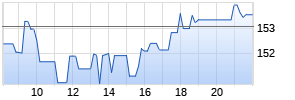
AbbVie Announces Late-Breaking Data at AAN Supporting Long-Term Safety and Efficacy of Atogepant (QULIPTA®) for Preventive Treatment of Migraine
PR Newswire
NORTH CHICAGO, Ill., April 12, 2024
- Interim analysis of an ongoing 156-week extension study supports long-term safety, tolerability and efficacy of atogepant 60 mg to prevent chronic and episodic migraine
- Seventy percent of subjects achieved ≥50% reduction in monthly migraine days at Weeks 13-16 and this was consistent during the 48 weeks of open-label treatment
- Findings will be showcased in an oral presentation at the American Academy of Neurology (AAN) Annual Meeting Scientific Platform Session for Emerging Science
NORTH CHICAGO, Ill., April 12, 2024 /PRNewswire/ -- AbbVie (NYSE: ABBV) today announced an interim analysis of an ongoing Phase 3, open-label 156-week extension study evaluating the long-term safety and tolerability of oral atogepant for the prevention of migraine in participants with chronic or episodic migraine. The overall long-term safety results were consistent with the known safety profile of atogepant in chronic and episodic migraine, and no new safety signals were identified. These results also support improvements in key efficacy outcomes, including reduction in monthly acute medication use days.
"Migraine is a debilitating neurological disease that can have a significant impact on day-to-day life," said Sait Ashina, MD, assistant professor of neurology and anesthesia at Harvard Medical School, director of the Comprehensive Headache Center at Beth Israel Deaconess Medical Center in Boston, and lead author of the study. "As the first report of one-year atogepant data in patients with chronic migraine, this builds on the long-term observed safety and efficacy in the episodic migraine population and demonstrates atogepant's ability to reduce migraine days and acute medication use across the spectrum of the disease."
The extension study included participants who had enrolled in the Phase 3 PROGRESS and ELEVATE clinical trials with a baseline monthly migraine day burden of 14.5 days and completed these studies. Key findings from the interim analysis include:
- Monthly migraine days improved on average by 8.5 days at Weeks 13-16 and this was consistent over 48 weeks. Similar improvements were observed for monthly headache days and monthly acute medication use days.
- Seventy percent of subjects achieved ≥50% reduction in monthly migraine days at Weeks 13-16 and this was consistent during the 48 weeks of open-label treatment.
- Overall safety results were consistent with the known safety profile of atogepant 60 mg, and no new safety signals were identified.
- The most common treatment-emergent adverse events (≥5%) were COVID-19 (28.7%), nasopharyngitis (10.9%), and constipation (8.2%).
"We understand that migraine is a complex disease and AbbVie is steadfast in our commitment to alleviating the considerable burden facing migraine patients," said Dawn Carlson, vice president, neuroscience development, AbbVie. "Patients should accept nothing less than migraine freedom, and the long-term safety and efficacy shown in this interim analysis marks another step toward that goal."
Atogepant, also known as QULIPTA® in the U.S. and AQUIPTA® in the European Union (EU), is approved in 45 countries. It is an oral calcitonin gene-related peptide (CGRP) receptor antagonist proven to prevent both episodic and chronic migraine in adults.
AbbVie will continue to pursue additional regulatory submissions for atogepant across international markets.
About Study 3101-312-002
Study 3101-312-002 is an ongoing Phase 3, multicenter, open-label 156-week extension study evaluating the long-term safety and tolerability of oral atogepant for the prevention of migraine in participants with chronic or episodic migraine. The primary objective was to evaluate safety and tolerability in all participants who received ≥1 dose of study intervention in the extension study (N = 595). Efficacy was evaluated by eDiary at Weeks 13-16, 29-32 and 45-48. The modified intention-to-treat population included participants who received ≥1 dose of atogepant and had ≥1 evaluable post-baseline 4-week period of eDiary data (N=524). Pre-specified efficacy endpoints included in the late-breaking data included change from baseline in monthly migraine days, monthly headache days, monthly acute medication use days and the proportion of participants with ≥ 50% improvement in monthly migraine days. The current interim analysis was performed after all study participants completed the efficacy data collection portion of the study at Week 52 or early termination. More information can be found on www.clinicaltrials.gov (NCT04686136).
About the ELEVATE Study
The ELEVATE study was a global, randomized, double-blind, placebo-controlled trial assessing the safety, tolerability, and efficacy of atogepant 60 mg once daily (QD) compared with placebo for the preventive treatment of episodic migraine in adult participants who have been failed by two to four classes of oral preventive treatments. The primary endpoint was the change from baseline in mean monthly migraine days (MMDs) across 12 weeks. Secondary endpoints included achievement of more than 50% reduction in MMDs, change from baseline in mean monthly headache days (MHDs), and change from baseline in acute medication use days across 12 weeks. More information can be found on www.clinicaltrials.gov (NCT04740827).
About the PROGRESS Study
The PROGRESS study was a global, randomized, double-blind, placebo-controlled Phase 3 trial assessing the efficacy, safety, and tolerability of atogepant for the preventive treatment of chronic migraine. Adults with a 1-year or longer history of chronic migraine were randomly assigned (1:1:1) to receive oral atogepant 30 mg twice a day (not a U.S. FDA-approved dose), oral atogepant 60 mg once a day, or placebo. The primary endpoint was change from baseline in mean monthly migraine days (MMDs) across the 12-week treatment period. Key secondary endpoints for all regions included proportion of participants with at least a 50% reduction in MMDs across the 12-week treatment period, change from baseline in mean monthly headache days (MHDs) across the 12-week treatment period, and change from baseline in mean monthly acute medication use days across the 12-week treatment period. More information can be found on www.clinicaltrials.gov (NCT03855137).
About Atogepant (QULIPTA®)
Atogepant is an orally administered, CGRP receptor antagonist specifically developed for the preventive treatment of migraine in adults. CGRP and its receptors are expressed in regions of the nervous system associated with migraine pathophysiology. Studies have shown that CGRP levels are elevated during migraine attacks and selective CGRP receptor antagonists confer clinical benefit in migraine.
Atogepant, known as AQUIPTA® in the European Union, was approved by the European Commission in August 2023 for the prevention of episodic or chronic migraine in adults with 4 or more monthly migraine days (MMDs).
IMPORTANT SAFETY INFORMATION
Do not take QULIPTA if you have had an allergic reaction to atogepant or any ingredients in QULIPTA.
Before taking QULIPTA, tell your healthcare provider about all your medical conditions, including if you:
- Have kidney problems or are on dialysis
- Have liver problems
- Are pregnant or plan to become pregnant. It is not known if QULIPTA will harm your unborn baby
- Are breastfeeding or plan to breastfeed. It is not known if QULIPTA passes into your breast milk. Talk to your healthcare provider about the best way to feed your baby while taking QULIPTA
Tell your healthcare provider about all the medicines you take, including prescription and over-the-counter medicines, vitamins, and herbal supplements. QULIPTA may affect the way other medicines work, and other medicines may affect how QULIPTA works. Your healthcare provider may need to change the dose of QULIPTA when taken with certain other medicines.
QULIPTA can cause serious allergic reactions, like anaphylaxis, that can happen when you take QULIPTA or days after. Stop taking QULIPTA and get emergency medical help right away if you get any of the following symptoms, which may be part of a serious allergic reaction: swelling of the face, lips, or tongue; itching; trouble breathing; hives; or rash.
The most common side effects of QULIPTA are nausea, constipation, and fatigue/sleepiness. These are not all the possible side effects of QULIPTA.
QULIPTA is available in 10 mg, 30 mg, and 60 mg tablets.
You are encouraged to report negative side effects of prescription drugs to the FDA. Visit www.fda.gov/medwatch or call 1-800-FDA-1088.
If you are having difficulty paying for your medicine, AbbVie may be able to help. Visit AbbVie.com/myAbbVieAssist to learn more.
Please see full Prescribing Information.
Globally, prescribing information varies; refer to the individual country product label for complete information.
About Migraine and Chronic Migraine
Migraine is a complex neurological disease with recurrent attacks that are often incapacitating and characterized by severe, throbbing headache pain as well as compounding associated symptoms like extreme sensitivity to light, sound or nausea.1 It is highly prevalent, affecting more than 1 billion people worldwide, including nearly 40 million people in the United States alone, and is the highest cause of disability worldwide for people under 50 years of age.2-5
People living with chronic migraine experience headaches or migraine for 15 or more days per month, with at least eight of those days associated with migraine.6 It is differentiated from episodic migraine, which is characterized by 0-14 headache days per month,7 by its more debilitating disease profile including greater prevalence of comorbid conditions as well as higher frequency of headache and migraine days.7-9 Individuals with chronic migraine experience frequent disabling migraine attacks, preventing them from performing daily activities and significantly affecting their quality of life. This results in substantial societal and familial burden.10-14 Significant direct and indirect costs are also associated with chronic migraine, leading to economic burden for patients and healthcare systems.15-17
About AbbVie in Migraine
AbbVie is the only company with three prescription treatments designed to meet patient needs across the full spectrum of migraine to help patients living with this debilitating disease.
At AbbVie, we are committed to empowering people living with migraine disease. We advance science that enables healthcare providers to care for people impacted across the spectrum of migraine. Through education and partnerships with the migraine community, we strive to help those with migraine navigate barriers to care, access effective treatments and reduce the impact of migraine on their lives.
About AbbVie in Neuroscience
At AbbVie, our commitment to preserving personhood of people around the world living with neurological and psychiatric disorders is unwavering. With more than three decades of experience in neuroscience, we are providing meaningful treatment options today and advancing innovation for the future. AbbVie's Neuroscience portfolio consists of approved treatments in neurological conditions, including migraine, movement disorders, and psychiatric disorders, along with a robust pipeline of transformative therapies. We have made a strong investment in research and are committed to building a deeper understanding of neurological and psychiatric disorders. Every challenge makes us more determined and drives us to discover and deliver advancements for those impacted by these conditions, their care partners, and clinicians. For more information, visit www.abbvie.com.
About AbbVie
AbbVie's mission is to discover and deliver innovative medicines and solutions that solve serious health issues today and address the medical challenges of tomorrow. We strive to have a remarkable impact on people's lives across several key therapeutic areas – immunology, oncology, neuroscience, and eye care – and products and services in our Allergan Aesthetics portfolio. For more information about AbbVie, please visit us at www.abbvie.com. Follow @abbvie on LinkedIn, Facebook, Instagram, X (formerly Twitter), and YouTube.
Forward-Looking Statements
Some statements in this news release are, or may be considered, forward-looking statements for purposes of the Private Securities Litigation Reform Act of 1995. The words "believe," "expect," "anticipate," "project" and similar expressions and uses of future or conditional verbs, generally identify forward-looking statements. AbbVie cautions that these forward-looking statements are subject to risks and uncertainties that may cause actual results to differ materially from those expressed or implied in the forward-looking statements. Such risks and uncertainties include, but are not limited to, challenges to intellectual property, competition from other products, difficulties inherent in the research and development process, adverse litigation or government action, and changes to laws and regulations applicable to our industry. Additional information about the economic, competitive, governmental, technological and other factors that may affect AbbVie's operations is set forth in Item 1A, "Risk Factors," of AbbVie's 2023 Annual Report on Form 10-K, which has been filed with the Securities and Exchange Commission, as updated by its subsequent Quarterly Reports on Form 10-Q. AbbVie undertakes no obligation, and specifically declines, to release publicly any revisions to forward-looking statements as a result of subsequent events or developments, except as required by law.
US-QLP-240094
References:
- Headache Classification Committee of the International Headache Society (IHS) The International Classification of Headache Disorders, 3rd edition. Cephalalgia. 2018;38:1-211.
- Amiri P, Kazeminasab S, Nejadghaderi SA, Mohammadinasab R, Pourfathi H, Araj-Khodaei M, Sullman MJM, Kolahi AA, Safiri S. Migraine: A Review on Its History, Global Epidemiology, Risk Factors, and Comorbidities. Front Neurol. 2022 Feb 23;12:800605. doi: 10.3389/fneur.2021.800605. PMID: 35281991; PMCID: PMC8904749.
- Steiner, T. J., Stovner, L. J., Vos, T., Jensen, R., & Katsarava, Z. Migraine is first cause of disability in under 50s: Will health politicians now take notice? J Headache Pain. 2018;19:17.
- AbbVie. Data on File: ABVRRTI73750
- Katsarava Z, Buse DC, Manack AN, Lipton RB. Defining the differences between episodic migraine and chronic migraine. Curr Pain Headache Rep. 2012;16:86-92.
- Headache Classification Committee of the International Headache Society (IHS) The International Classification of Headache Disorders, 3rd edition. Cephalalgia. 2018;38:1-211.
- Katsarava Z, Buse DC, Manack AN, Lipton RB. Defining the differences between episodic migraine and chronic migraine. Curr Pain Headache Rep. 2012;16:86-92.
- Buse DC, Manack A, Serrano DC, et al. Sociodemographic and comorbidity profiles of chronic migraine and episodic migraine sufferers. J Neurol Neurosurg Psychiatry. 2010;81:428-432.
- Adams AM, Serrano D, Buse DC, et al. The impact of chronic migraine: The Chronic Migraine Epidemiology and Outcomes (CaMEO) Study methods and baseline results. Cephalalgia. 2015;35(7) 563-578.
- Blumenfeld A, Varon S, Wilcox TK, et al. Disability, HRQoL and resource use among chronic and episodic migraineurs: results from the International Burden of Migraine Study (IBMS). Cephalalgia. 2011;31:301-315.
- Lantéri-Minet M, Duru G, Mudge M, Cottrell S. Quality of life impairment, disability and economic burden associated with chronic daily headache, focusing on chronic migraine with or without medication overuse: a systematic review. Cephalalgia. 2011;31:837-850.
- Buse DC, Scher AI, Dodick DW, et al. Impact of migraine on the family: perspectives of people with migraine and their spouse/domestic partner in the CaMEO Study. Mayo Clin Proc. 2016;91:596-611.
- Buse DC, Powers SW, Gelfand AA, et al. Adolescent perspectives on the burden of a parent's migraine: results from the CaMEO study. Headache. 2018;58:512-524.
- Buse DC, Murray S, Dumas PK, et al. Life with migraine, effect on relationships, career and finances, and overall health and well-being results of the Chronic Migraine Epidemiology and Outcomes (CaMEO) Study. Cephalalgia. 2018;38(Suppl 1):9-10.
- Messali A, Sanderson JC, Blumenfeld AM, et al. Direct and indirect costs of chronic and episodic migraine in the United States: a web-based survey. Headache. 2016;56:306-322.
- Sanderson JC, Devine EB, Lipton RB, et al. Headache-related health resource utilization in chronic and episodic migraine across six countries. J Neurol Neurosurg Psychiatry. 2013;84:1309-1317.
- Blumenfeld AM, Varon SF, Wilcox TK, et al. Disability, HRQoL and resource use among chronic and episodic migraineurs: Results from the International Burden of Migraine Study (IBMS). Cephalalgia. 2011;31:301-315.
![]() View original content to download multimedia:https://www.prnewswire.com/news-releases/abbvie-announces-late-breaking-data-at-aan-supporting-long-term-safety-and-efficacy-of-atogepant-qulipta-for-preventive-treatment-of-migraine-302114992.html
View original content to download multimedia:https://www.prnewswire.com/news-releases/abbvie-announces-late-breaking-data-at-aan-supporting-long-term-safety-and-efficacy-of-atogepant-qulipta-for-preventive-treatment-of-migraine-302114992.html
SOURCE AbbVie

Mehr Nachrichten zur AbbVie Inc. Aktie kostenlos abonnieren
(Mit der Bestellung akzeptierst du die Datenschutzhinweise)

Hinweis: ARIVA.DE veröffentlicht in dieser Rubrik Analysen, Kolumnen und Nachrichten aus verschiedenen Quellen. Die ARIVA.DE AG ist nicht verantwortlich für Inhalte, die erkennbar von Dritten in den „News“-Bereich dieser Webseite eingestellt worden sind, und macht sich diese nicht zu Eigen. Diese Inhalte sind insbesondere durch eine entsprechende „von“-Kennzeichnung unterhalb der Artikelüberschrift und/oder durch den Link „Um den vollständigen Artikel zu lesen, klicken Sie bitte hier.“ erkennbar; verantwortlich für diese Inhalte ist allein der genannte Dritte.





